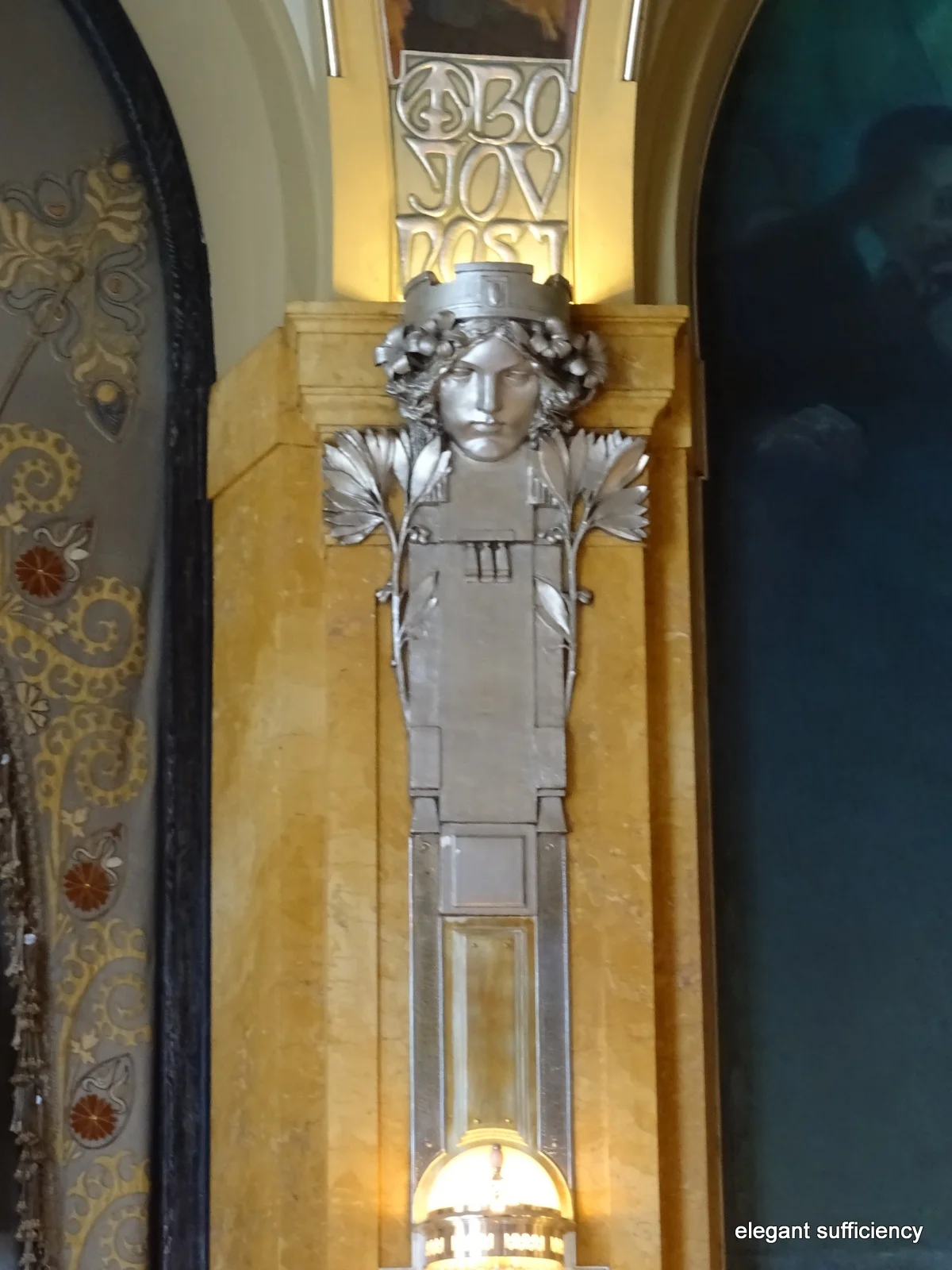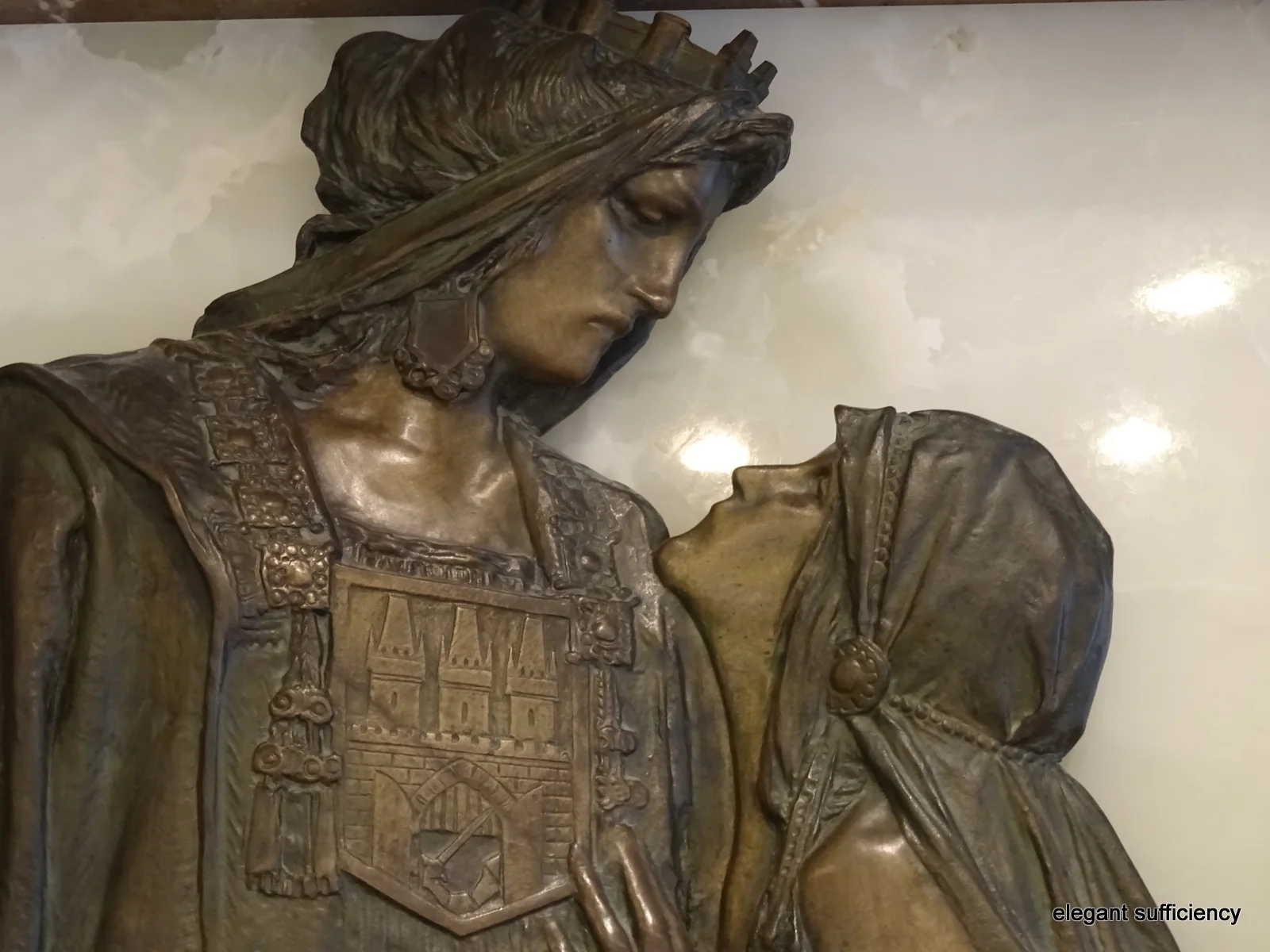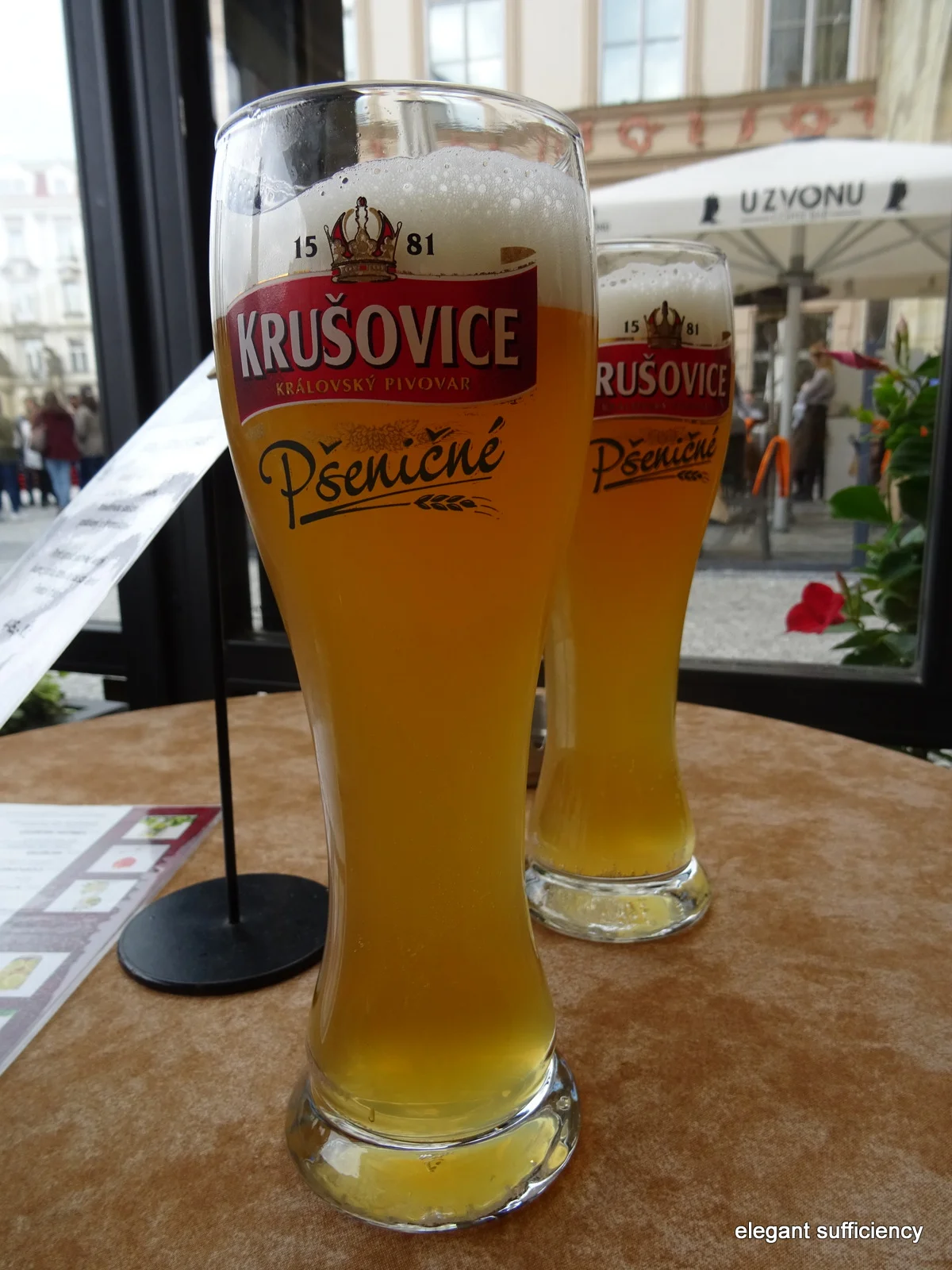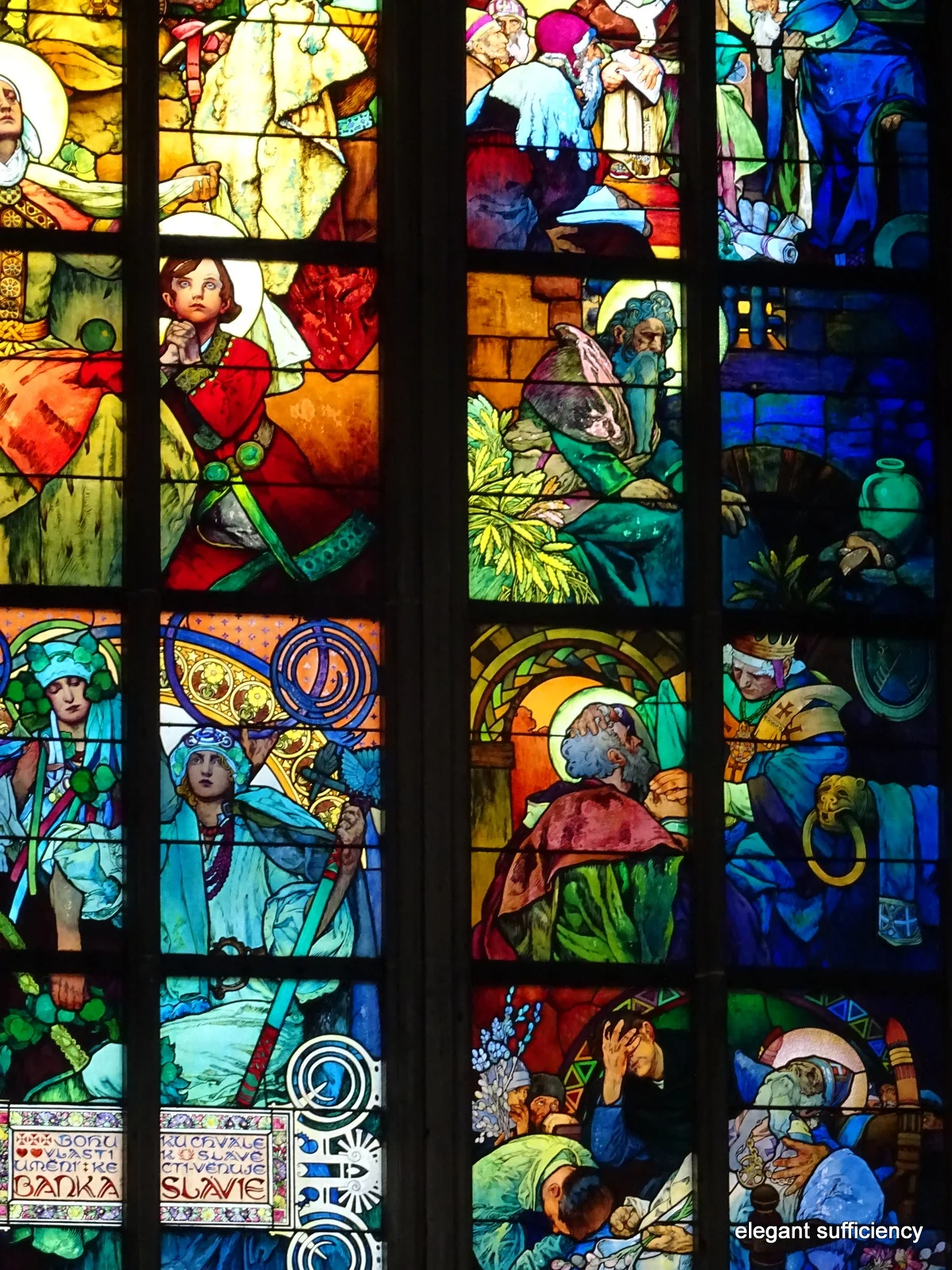The Muncipal House
At home, anything with the word “municipal” in it is likely to be dull. Worthy and possibly a bit down at heel, budgets always being tightened.
The Municipal House here in Prague is anything but. Built at the start of the 20th century as a showcase of design and craftsmanship, the budget was doubled, even before it was finished. It stands as a masterpiece of Art Nouveau design and I wanted to take a closer look.
The only way to do that is to join a guided tour and having timed my arrival well, I was able to buy a ticket and stand by and wait a short while for it to begin.
Not only was I going to join a tour group (aaagh) but I had to buy (and wear) an additional photo pass around my neck as well.
It had better be worth it!
I had already snapped the logo of the building, admiring the design and cursing the spotlights which make taking photographs of shiny things so tricky.
We were a large group of at least twenty people and I lamented the fact that the previous group; the one I’d just missed, left with only a dozen. Still, their guide seemed crabby and unsmiling, whereas our sweet Andrea was utterly charming.
Our first stop was outside the Mayor’s Hall. Andrea explained that there was a function booked for this afternoon so we were going to begin there and do the tour in reverse order. As she spoke, cameras were clicking all over – I mean, this building is just so photogenic!
When she opened the door, I swear there was a collective gasp. But Ms Crabby and her small group were just coming through and it appeared she was going to pull rank. Oh no! did this mean we were not going to have any time in here?
We snipped and snapped, just in case! My eyes fell immediately on those embroidered felt curtains, then slid over to the light fittings…but it appeared we were moving right along through those doors and we just had to follow and keep our fingers crossed that we’d be back.
We began in the room known as the Conference Hall and Andrea immediately reassured us that we would indeed see everything there was to see, but in reverse order. Phew. She spoke in both English and Czech which was great, because it gave me time to scribble as she talked and then look more closely during the Czech bits.
I was smitten with the attention to detail. The small motifs that were repeated here and there, on curtains, on walls, on the ceiling and on fixtures and fittings.
It was all in the detail and the craftsmanship. Oh my goodness. Where to look first? Next? Have I seen everything? Has anything gone unnoticed?
It was in this room where Andrea gave us an overview of the building, for it was here that the formation of Czechoslovakia was proclaimed in 1918. It was also here where Vaclav Havel negotiated the settlement in 1989: the building holds huge significance in the country’s history but nevertheless, it’s a building for the people, who are invited to hold meetings, parties, weddings and any other event here.
All the time Andrea spoke, I was looking around, scribbling, noting patterns and it appeared everyone else was doing the same!
Time to move into the next room, then; the one we’d just walked through, in between the Mayor’s Hall and the Conference Hall, the Rieger Hall.
Here, the significant feature was a pair of large murals depicting prominent Czech artists. Andrea identified them one by one but I caught only the first two from the right hand side: Antonin Dvorak and Bedrich Smetana.
It’s not that I wasn’t listening, but there were some rather beautifully embroidered felt cushions on the seats!
The ceiling was pretty spectacular too.
And all the time, I was wondering who Fr Lad Rieger was as well! I’m sure you can picture the scene: There I was scribbling, taking pictures, juggling notebook and camera, trying to look at everything, listening to Andrea and my mind going twenty to the dozen remembering to look things up later and just make a note for now.
As we gazed at the ceiling, Andrea noted the lime leaf motif and explained it as the “national tree of Prague”. It was a motif to be found throughout the building.
She also pointed out the carved hop design in the wooden door and window frames. It too is a traditional Czech motif, associated with the manufacture of beer, of course.
From here, it was just step back into the Mayor’s Hall, where we’d started. My priorities were to take a closer look at those curtains!
Beautiful work, lavish embroidery with crystals and wool appliques.
But of course, there was so much more to see. We’d learned early on from Andrea that only the best artists and craftsmen had been invited to contribute to the building, but that this room had been the work on one single designer: Alfons Mucha. I had already seen some of his work in the gallery this morning, but here was his masterpiece. He had sole responsibility for the design and execution and had given his services free of charge.
Only temporarily distracted by the view from the open window, I thought it was clear that, even though he was working voluntarily, Alfons Mucha certainly did not cut any corners.
Every detail from the small lamps at the end of each settee to the lavish paintings on the ceiling had been done with huge consideration.
Everyone was similarly enchanted by the whole room, but especially by the faces high above us.
Those very special, Mucha-faces!
And although I, too, was similarly captivated by them, I was also acutely aware of the other small details, such as the light fittings on each pillar
and the curtain tie-backs, which were a kind of elaborate tassel.
Oh my goodness, where to look next?
Well, upwards, i suppose. Having satisfied myself that I’d noticed everything in the room, I allowed myself to gaze at the ceiling.
The composition and placement of these two figures was fairly typical of these triangular segments – how intriguing to allow one figure to go beyond the edges, but how effective, too.
Did I say I’d noted everything? Well, spotting one member of our group paying attention to the chairbacks, I took note too…and look what was there, what I’d missed!
I realise that my photographs give only a glimpse of the reality and can only say, you need to see it for real!
It would be wrong to say it was downhill from now on, but there’s no doubt that having seen the diamond in the crown, the remaining part of the tour went rather more quickly.
The Palacký Hall was beautiful, for sure and the ceiling painting absolutely delightful.
It was here where Andrea pointed out the door handles
and didn’t need to point out the wall paintings which were also lovely.
From there, we moved on into the Grégr Hall, where another large wall painting dominated the room.
The lamps were especially lovely, and as Andrea had explained, since the Municipal House had been built to accommodate all the latest technological advances, the electric lighting was installed as part of the original design, together with central heating/cooling.
In here were marble panels and the most beautifully carved doors, too. At this point, though, Andrea remarked that we were leaving the men’s rooms and entering those of the ladies. I didn’t get chance to ask her to clarify so we’ll just take her word for it.
The next room, around the corner, was filled with light wood and pale blue upholstery. It’s known as the Oriental Parlour and many of the motifs are taken from eastern art and culture which was particularly fashionable at the time.
More lovely embroidered cushions
a ceiling with a feeling of Klimt’s art, I felt
and lamps based on the design of a minaret.
The patterns and detailing on the furniture were as consistent as previous rooms. Every last corner was perfect. No expense spared to achieve the best effect.
The wallpaper (or was it painted?) was inspired by ikat weaving, the jewelled arches from a temple. The whole effect was lovely.
The pattern continued onto the net curtains which were forming a really interesting shadow on the windowsill too!
Then, just as we were about to move into the next room, I spotted the ventilation grille – oh yes, every detail considered. Nothing left to chance.
I was so busy looking everywhere, I probably forgot to look down enough, but when I did, there was a small reward for doing so!
There followed a small room, almost too small to be classed as a room at all but dedicated to Božena Němcová, a Czech writer. The tiled fountain was exquisite, as you can see.
On going into the next parlour though, our eyes fell immediately to this part of the construction – a permanent feature of the room, for sure. We all peered into it, where a few air plants and stones were carefully arranged. But it’s purpose? An aquarium!
This was the Moravian Parlour, decorated with folk motifs and crafts of the area, including this wonderful ceiling.
Each motif surrounding the central pattern is taken from a traditional Moravian design.
There’s a lovely landscape on one of the wall panels, too.
But I had eyes mostly for the embroidered panels above each door
stitched on linen with crystals and pulled work motifs
and believe it or not, macrame curtains!
The last of these parlours was described by Andrea as “the confectionery”. A kind of refreshment room, it was arranged with a set of tables and chairs.
But there was one main focus: a broad bar/servery with the original fittings still in place.
Of course, there’s the same detailing and chandelier design, the table centres are gilded and shaped to reflect the overall design too. Once more, we all stood, open mouthed, not quite knowing where to look next.
Andrea must have seen this frequently in the groups she guides around the building, though of course, we were taking the tour in reverse order, so last, but not least, she took us into the hall where she normally begins the tour: The Smetana Hall.
This is a large concert hall, home to the Czech Philharmonic and named after the composer of the seminal patriotic work Ma Vlast. The stone statues on either side of the stage are inspired by pieces of that work and the whole design reflects the overall theme.
On each side of the hall is a large oval balcony with two large paintings. On this side, there’s music and dance depicted
and here, on the other side, there’s poetry and drama.
The crowning glory above it all is the glazed dome. Spectacular.
Further glazed panels to either side as well!
The communists would have dearly loved to have demolished the lot, so much did they despise the decadence of the Art Nouveau. But thankfully their mere neglect of maintenance was repairable and over the years, the restoration has continued. What remains is an absolute treasure and clearly, it’s cherished by the people of Prague.
So it was from here, the balcony outside the Mayor’s Hall, where that proclamation was made in 1918 and again, in 1989 where Vaclav Havel stood during the Velvet Revolution.
What an amazing place!











